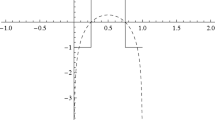Abstract
In a recent article (Found Sci (2020) https://doi.org/10.1007/s10699-020-09666-0) Marek Czachor claims that the Bell inequality cannot be proved because variables of complementary measurements cannot be added or multiplied. Even though he has correctly identified the problems existing with the orthodox interpretation of the Bell inequality and dealt with them in an original way, the interpretation he addresses do not pertain to the original formulation given by John Stewart Bell.
Similar content being viewed by others
Notes
In fact, we do not even know if such hidden variables exist, it is the result found in the experiment that falsifies their existence.
We do not know if De Baere would agree with this interpretation, but we do credit him for the idea and the terminology.
This manuscript contains two theorems proving the physical irrelevance of the counterfactual definiteness hypothesis.
Sometimes this view takes the form of a presumed hidden assumption made by Bell, for a discussion see Lambare (2017b).
References
Bell, J. S. (1964). On the Einstein–Podolsky–Rosen paradox. Physics, 1, 195–200.
Bell, J. S. (1976). The Theory of Local Beables. Epistemological Letters, March 1976.
Bell, J. S. (1981). Bertlmann’s socks and the nature of reality. Journal of Physque, 42, 41–61.
Clauser, J. F., Horne, M. A., Shimony, A., & Holt, R. A. (1969). Proposed experiment to test local hidden-variables theories. Physics Review Letters, 23, 880–884.
Czachor, M. (2020a). A Loophole of All ’Loophole-Free’ Bell-Type Theorems. Foundations of Science,. https://doi.org/10.1007/s10699-020-09666-0.
Czachor, Marek (2020b). Arithmetic loophole in Bell’s theorem: An overlooked threat for entangled-state quantum cryptography. arXiv:2004.04097 [physics.gen-ph]
De Baere, W. (1984). On the significance of Bell’s inequality for hidden-variables theories. Lettere Al Nuove Cimento, 39, 234–238.
Gill, R. D. (2014). Statistics, causality and Bell’s theorem. Statistical Science, 29, 512–528.
Lambare, J. P. (2017). On CHSH form of Bell’s inequalities. Foundations of Physics, 47, 321–326.
Lambare, J. P. (2017). On Nieuwenhuizen’s treatment of contextuality in Bell’s Theorem. Foundations of Physics, 47, 1591–1596.
Lambare, Justo Pastor (2019). Bell inequalities, Counterfactual Definiteness and Falsifiability. arXiv:1911.00343 [quant-ph]
Stapp, H. P. (1971). S-matrix interpretation of quantum theory. Physics Review D, 6B, 1303–1320.
Author information
Authors and Affiliations
Corresponding author
Ethics declarations
Conflict of interest
The author states that there is no conflict of interest.
Additional information
Publisher's Note
Springer Nature remains neutral with regard to jurisdictional claims in published maps and institutional affiliations.
Rights and permissions
About this article
Cite this article
Lambare, J.P. Comment on “A Loophole of All “Loophole-Free” Bell-Type Theorems”. Found Sci 26, 917–924 (2021). https://doi.org/10.1007/s10699-020-09695-9
Published:
Issue Date:
DOI: https://doi.org/10.1007/s10699-020-09695-9




